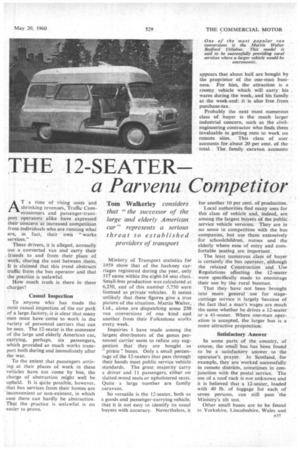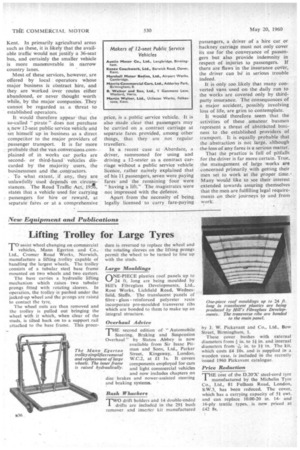THE 12-SEATER a Parvenu Competitor
Page 69

Page 70

If you've noticed an error in this article please click here to report it so we can fix it.
AT a time of rising costs and shrinking revenues, Traffic Commissioners and passenger-transport operators alike have expressed their concern at increased competition from individuals who are running what are, in fact, their own " works services."
These drivers, it is alleged, normally use a converted van and carry their friends to and from their place of work, shariug the cost between them. It is claimed that this trend abstracts traffic from the bus operator and that the practice is unlawful.
How much truth is there in these charges?
Casual Inspection
To anyone who has made the most casual inspection of the car park of a large factory, it is clear that many men must have come to work in the variety of personnel carriers that can be seen. The 12-seater is the successor of the large and elderly American car, carrying, perhaps, six passengers, which provided so much works transport both during and immediately after the war.
To the extent that passengers arriving at their places of work in these vehicles have not come by bus, the charge of abstraction might well be upheld. It is quite possible, however, that bus services from their homes are inconvenient or non-existent, in which case there can hardly be abstraction. That the practice is unlawful is no easier to prove.
Ministry of Transport statistics for 1959 show that of the hackney carriages registered during the year, only 517 came within the eight-14 seat class.. Small-bus production was calculated at 6,250, and of this number 5,750 were licensed as private 'vehicles. It seems unlikely that these figures give a true picture of the situation. Martin Walter, Ltd., alone are dispatching some 250 van conversions of one kind and another from their Folkestone works every week.
Inquiries I have made among the largest distributors of the genus personnel carrier seem to refute any suggestion that they are bought as "pirate buses. Only a small percentage of the 12-seaters that pass through their hands meet public service vehicle standards. The great majority carry a driver and 11 passengers, either on slatted.wood seats or upholstered seats. Quite a large 'number are family caravans.
So versatile is the 12-seater, both as a goods and passenger-carrying vehicle, that it is not easy to identify its usual buyers with accuracy. Nevertheless, it appears that about half are bought by the proprietor of the one-man business. For him, the attraction is a roomy vehicle which will carry his wares during the week, and his family at the week-end: it is also free from purchase-tax.
Probably the next most numerous class of buyer is the much larger industrial concern, such as the civilengineering contractor who finds them invaluable in getting men to work on remote sites. This class of user accounts for about 20 per cent. of the total. The family caravan accounts for another 10 per cent. of production.
Local authorities find many uses for this class of vehicle and,, indeed, are among the largest buyers of the public service vehicle versions. They are in no sense in competition with the bus companies, but use them extensively for schoolchildren, nurses and the elderly where ease of entry and comfortable seating are important.
The least numerous class of buyer is certainly the bus operator, although the relaxed Construction and Use Regulations affecting the 12-seater were specifically made to encourage their use by the rural busman.
That they have not been brought into. more general . use for stagecarriage service is largely because of the fact that a man's wages are much the same whether he drives a 12-seater or a 41-seater. Where one-man .operation is accepted, the larger bus is a more attractive proposition.
Satisfactory Answer
In some parts of the country, of course, the small bus has been found to be a satisfactory answer to the operator's prayer. In Scotland, for example, they are worked successfully in remote districts, sometimes in conjunction with the postal service. The use of a roof rack is not unknown and it is believed that a 12-seater, loaded with 40 lb. of luggage for each of seven persons, can still pass the Ministry's tilt test.
Other small buses are to be found in Yorkshire, Lincolnshire, Wales and B35 Kent. In primarily agricultural areas such as these, it is likely that the available traffic would not justify a 36-seat bus, and certainly the smaller vehicle is more manceuvrable in narrow country lanes.
Most of these services, however, are offered by local operators whose major business is contract hire, and they are worked over routes either abandoned, or never thought worth while, by the major companies. They cannot be regarded as a threat to established operators.
It would therefore appear that the so-called " pirate " does not purchase a, new 12-seat public service vehicle and set himself up in business as a direct competitor to the major providers of passenger transport. It is far more probable that the van conversions.complained of in works car parks are secondor third-hand vehicles discarded by the majority users, the businessmen and the contractors.
. To what extent, if any, they are unlawfully used depends on circuwstances. The Road Traffic Act, 195T, states that a vehicle used for carrying passengers for hire or reward, at separate fares or at a comprehensive price, is a public service vehicle. It is also made clear that passengers may be carried on a contract carriage at separate fares provided, among other things, that they are not regular travellers.
In a recent case at Aberdare, a driver, summoned for using and driving a 12-seater as a contract carriage without a public service vehicle licence, rather naively explained that of his 11 passengers, seven were paying fares and the remaining four were "having a lift." The magistrates were not impressed with the defence.
Apart from the necessity of being legally licensed to carry fare-paying
passengers, a driver of a hire car or hackney. carriage must not only cover its use for the conveyance of passengers but also provide indemnity in respect of injuries to passengers. If there are flaws in the insurance cover, the driver can be in serious trouble indeed.
It is only too likely that many converted vans used on the daily run to the works are covered only by thirdparty insurance. The consequences of a major accident, possibly involving loss of life, are grim to contemplate.
It would therefore seem that the activities of these amateur busmen represent a threat of abstracted busi ness to the established providers of transport. It is equally probable that the abstraction is not large, although the loss of any fares is a serious matter. That the practice is full of pitfalls for the driver is far more certain. True, the management of large works are concerned primarily with getting their men set to work at the proper time.'
Many would like to see their interest extended towards assuring themselves that the men are fulfilling legal requirements on their journeys to and from work.




















































































































